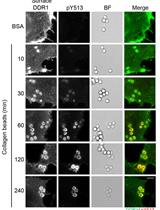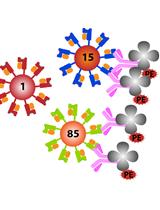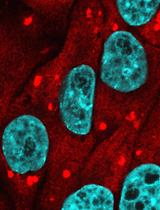- Submit a Protocol
- Receive Our Alerts
- EN
- EN - English
- CN - 中文
- Protocols
- Articles and Issues
- For Authors
- About
- Become a Reviewer
- EN - English
- CN - 中文
- Home
- Protocols
- Articles and Issues
- For Authors
- About
- Become a Reviewer
Binding to Secreted Bone Matrix in vitro
Published: Vol 4, Iss 4, Feb 20, 2014 DOI: 10.21769/BioProtoc.1030 Views: 9052
Reviewed by: Anonymous reviewer(s)

Protocol Collections
Comprehensive collections of detailed, peer-reviewed protocols focusing on specific topics
Related protocols

Cell-based Assay for Recruitment of DDR1 to Collagen-coated Beads
Victoria Juskaite and Birgit Leitinger
Aug 20, 2019 3994 Views

Assessments of HLA-I Specificities of Anti-HLA-I Monoclonal Antibodies Using Solid Phase Bead Arrays
Anita J. Zaitouna [...] Malini Raghavan
Jun 20, 2020 3753 Views

A Quantitative Assay to Measure Stress Granule Association of Proteins and Peptides in Semi-permeabilized Human Cells
Saskia Hutten and Dorothee Dormann
Dec 20, 2020 3531 Views
Abstract
This method examines the bone matrix binding capacity of proteins. Using osteogenic differentiation medium, multipotent stromal cells (MSC) are induced to differentiate into osteocytes in vitro and to secrete bone matrix. The latter is confirmed using Alizarin red S staining, which detects the presence of calcific deposits (hydroxyapatite). These calcific deposits are used to test the bone binding properties of proteins. The binding to the calcific deposits is assessed by Western blot analysis.
Materials and Reagents
- Multipotent stromal cells (MSC) isolated from mouse bone marrow [see protocol “Isolation of Multipotent Stromal Cells from Mouse Bone Marrow” (Tormo et al., 2014)]
- Dulbecco’s Modified Eagle’s Medium High glucose with stable L-glutamine (DMEM) (Wisent, catalog number: 319-015-CL )
- Penicillin/Streptomycin solution (Wisent, catalog number: 450-201-EL )
- Fetal Bovine Serum (FBS) (Life Technologies, Gibco®, catalog number: 12483 )
- 0.53 mM 0.05% Trypsin/EDTA (Wisent, catalog number: 325-042-EL )
- PBS without Ca2+ and Mg2+ (Wisent, catalog number: 311-01-CL )
- HEPES (Wisent, catalog number: 330-050-EL )
- 10 nM Dexamethasone (Sigma-Aldrich, catalog number: D4902 )
- 50 μM Ascorbic acid-2 phosphate (vitamin C) (Sigma-Aldrich, catalog number: A4403 )
- 50 nM Cholecalciferol (Vitamin D3) (Sigma-Aldrich, catalog number: C9756 )
- 10 mM B-glycerophosphate (Sigma-Aldrich, catalog number: G9891 )
- 100x Protease and phosphatase inhibitors (Thermo Fisher Scientific, Pierce, catalog number: PI78447 )
- IL-27 (1 μg) (R&D Systems, catalog number: 2799-ML-010/CF ) or any recombinant protein to be tested
- Bicinchoninic acid assay (BCA) (Thermo Fisher Scientific, Pierce, catalog number: PI23225 )
- Distilled water
- Ethanol
- Anti-IL-27 p28 biotinylated antibody (R&D Systems, catalog number: BAF1834 ) or biotinylated antibody specific for the protein to be tested
- Streptavidin-HRP (Thermo Fisher Scientific, Pierce, catalog number: PI21130 )
- SDS-PAGE loading buffer without bromophenol blue or DTT
- Urea buffer (Fisher Scientific, catalog number: BP169-10 )
- 1 M Sodium phosphate monobasic (Fisher Scientific, catalog number: BP330-1 )
- 1 M Sodium phosphate dibasic (Fisher Scientific, catalog number: BP332-1 )
- TBS-Tween
- 3% BSA
- Dexamethasone solution (see Recipes)
- 10x Glycerophosphate solution (see Recipes)
- 1,000x Vitamin C solution (see Recipes)
- Osteogenic differentiation medium (50 ml) (see Recipes)
- Alizarin red S (Sigma-Aldrich, catalog number: A5533 ) (see Recipes)
- Urea/Phosphate lysis buffer (see Recipes)
Equipment
- 15 ml tube
- Centrifuge for cell culture
- 6 well tissue culture plates (BD Biosciences, catalog number: DL-353046 )
- 96 well tissue culture plates with flat bottoms (BD Biosciences, catalog number: DL-353072 )
- Inverted phase-contrast microscope
- 37 °C, 5% CO2 cell culture incubator
- Cell scrapers (Corning, catalog number: 3010 )
- Microplate reader for BCA (562 nm)
- SDS-PAGE Equipment
- Western blot Equipment
Procedure
- MSC are rinsed gently one time with 2 ml of PBS and trypsinized. For cells trypsinization: add 0.5 ml of trypsin on the rinsed cells. Wait 3 to 5 min until cells peel off the plastic surface. Transfer cells in a 15 ml tube and add quickly 10 ml of DMEM containing 10 % FBS in order to inhibit trypsin action.
- The cells are pelleted at 435 x g for 5 min at 4 °C.
- The supernatant is removed and the cells are incubated in 6 wells plate at a density of 5,000-10,000 cells per well, in 2 ml of DMEM complemented with 10% FBS.
- The cells are incubated in the 5% CO2 incubator at 37 °C overnight.
- MSC are washed twice with PBS by adding and removing gently 2 ml of PBS per well without any agitation. Cells must be still adherent to the bottom of wells after washes. The adherent cells are then incubated with osteogenic differentiation medium.
- The osteogenic differentiation medium is changed every 2 days for 10 days.
- At day 10, the differentiated cells are washed with PBS and exposed to Alizarin red S preparation for 5 min at room temperature without any agitation.
- Cells are rinsed with distilled water and the red coloration indicating an osteogenic differentiation is assessed by microscopy (see Figure 1).

Figure 1. Multipotent stromal cells were differentiated into osteocytes for 10 d. Osteocyte differentiation was detected by Alizarin red S staining (Tormo et al., 2013). (Copyright 2013. The American Association of Immunologists, Inc)
- Each well is incubated with 1 μg IL-27 (or other molecules being tested) in 500 μl serum-free DMEM for 1 h on ice without agitation (verify that all the well is recovered by medium). DMEM alone is used as negative control.
- Cells are washed 5 times with 1 ml of ice-cold serum-free DMEM without agitation and scraped in 100 μl urea/phosphate lysis buffer supplemented with protease and phosphatase inhibitors.
- Lysates are transferred in 1.5 ml tubes and diluted 10 times with bromophenol blue-free and DTT-free SDS-PAGE loading buffer.
- Protein concentration is quantified using a BCA kit (follow manufacturer protocol) and 50 μg of the total protein is analysed by SDS-PAGE (after adding 5% b-mercaptoethanol to each tubes) and Western blot.
- IL-27 is detected after blocking the Western blot membrane 30 min at room temperature in TBS-Tween containing 3% BSA followed by successive incubation with biotinylated goat anti-mouse p28 Ab (incubated over-night at 4 °C) and HRP-labelled streptavidin (incubated 1 h at room temperature). All incubations are performed in TBS-Tween containing 3% BSA. Washes are performed following incubation with Ab or streptavidin. These membrane washes consist of 3 incubations of 10 min at room temperature in 20 ml of TBS-Tween with agitation.
Recipes
- 1,000x Dexamethasone solution
Dissolve 1.2 mg dexamethasone in 1,223 μl ethanol
Transfer 10 μl of this 2.5 x 10-3 M solution to 2.5 ml DMEM
This solution is now 1x10-5 M (1,000x)
- 10x Glycerophosphate solution
Dissolve 630 mg b-glycerophosphate in 20 ml DMEM/15 mM HEPES (pH 7.5)
Filter through a 0.22 μm pore size membrane under the tissue culture hood
- 1,000x Vitamin C solution
Dissolve 50 mg vitamin C in 10 ml DMEM/15 mM HEPES (pH 7.5)
Filter through a 0.22 μm pore size membrane under the tissue culture hood
- Osteogenic differentiation medium (50 ml)
5 μl dexamethasone at 0.5 mM (1,000x)
1 ml glycerophosphate at 500 mg/ml
50 μl vitamin C at 50 mM (1,000x)
50 μl vitamin D3 at 50 μM
5 ml FBS
Complete to 50 ml with DMEM
- Alizarin red S preparation
Phosphate-buffered saline (PBS) with 2% Alizarin red S
- (8 M) Urea/Phosphate 400 mM lysis buffer (pH 7.5) (100 ml)
Mix 77.4 ml of 1 M Na2HPO4 with 22.6 ml of 1 M NaH2PO4 to obtain 100 ml of 1 M phosphate buffer (pH 7.5)
Mix 48 g Urea with 40 ml of 1 M phosphate buffer (pH 7.5)
pH to 7.5 with Na2HPO4
Add dH2O to 100 ml
Note: Add 1x phosphatase and protease inhibitor (dilute the stock 1/100 in the desired volume of Urea/Phosphate solution to obtain 1x final concentration) just before using.
Acknowledgments
This protocol is adapted from Tormo et al. (2013).
References
- Tormo, A. J., Beaupre, L. A., Elson, G., Crabe, S. and Gauchat, J. F. (2013). A polyglutamic acid motif confers IL-27 hydroxyapatite and bone-binding properties. J Immunol 190(6): 2931-2937.
- Tormo, A. J., Rafei, M. and Gauchat, J. F. (2014). Isolation of multipotent stromal cells from mouse bone marrow. Bio-protocol 4(4): e1031.
Article Information
Copyright
© 2014 The Authors; exclusive licensee Bio-protocol LLC.
How to cite
Tormo, A. J., Beauséjour, C. and Gauchat, J. (2014). Binding to Secreted Bone Matrix in vitro. Bio-protocol 4(4): e1030. DOI: 10.21769/BioProtoc.1030.
Category
Biochemistry > Protein > Interaction
Cell Biology > Cell isolation and culture > Cell differentiation
Stem Cell > Adult stem cell > Stromal cell
Do you have any questions about this protocol?
Post your question to gather feedback from the community. We will also invite the authors of this article to respond.
Tips for asking effective questions
+ Description
Write a detailed description. Include all information that will help others answer your question including experimental processes, conditions, and relevant images.
Share
Bluesky
X
Copy link







